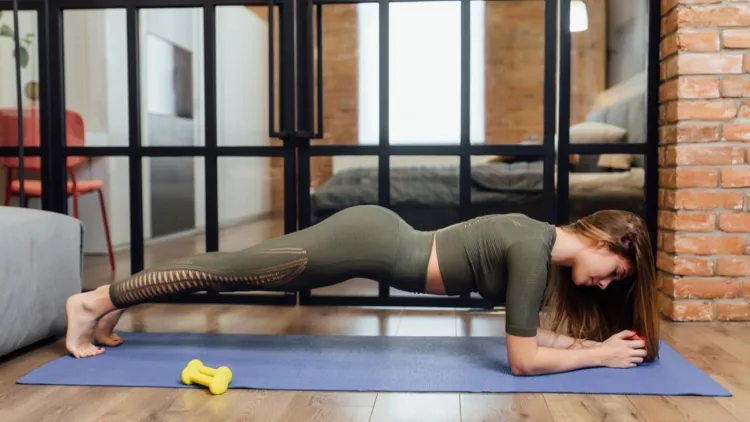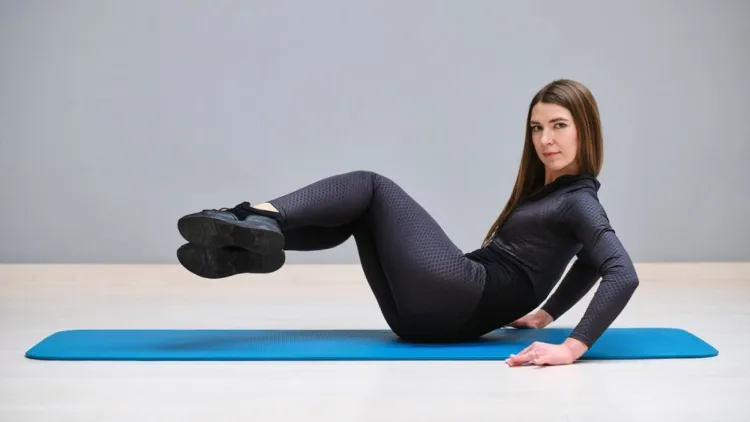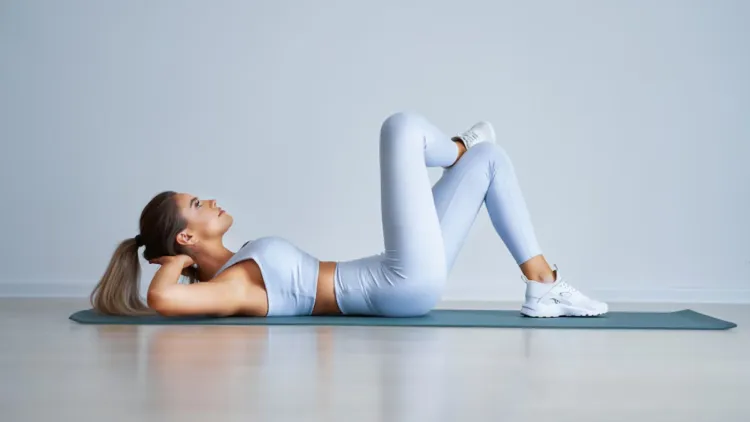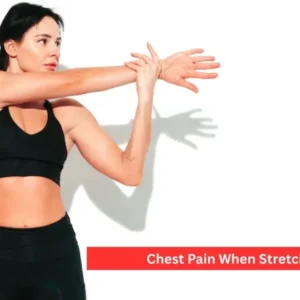There are also many benefits of the clamshell exercise, and it is a very effective and very straightforward lower body movement that mainly works on the outer thighs and hip abductors. This simple warm-up exercise could be done just about anywhere and has numerous advantages for the body, such as enhancing posture and ease of movement, and avoiding harm. In this blog post, let me list down the top 10 benefits of clamshell exercise and do’s and don’ts tips when doing clamshells to gain the best results.
What is the Clamshell Exercise?
The clamshell is another very effective exercise that works the hip abductors, especially the gluteus medius muscle. This unloaded exercise can be done from a lying down position, lying on your side, or even a standing position with your feet spread wide apart from each other. The main movement is the up and down motion of the top knee, and the bottom leg is to remain still. As the specialist mentioned, this exercise focuses on the gluteus medius and other hip muscles, making it an excellent inclusion in a lower body strength and stability program.

Muscles included in the Clamshell Exercise.
An exercise that greatly targets lower body muscles is called the clamshell exercise. It is mostly the gluteus medius that is affected, which plays a crucial role in hip abduction and external rotation. It also works the hip flexors, whose function is so important to stabilise the hip joint, but it also works the gluteus maximus – the largest muscle in the gluteal group. On the other hand, the exercise also works out other hip abductor muscles like the tensor fasciae latae and piriformis.
1. Strengthen Hip Abductors
The number one muscles targeted by clamshells are the hip abductors, gluteus medius and gluteus minimus, to be more specific. These muscles must assist in stabilising the pelvis and hips to maintain balance and correct alignment as we move.
It’s worth mentioning that while targeting the gluteus medius, the clamshell exercise also helps with overall hip strength, which is key to proper running posture and avoiding typical hip injuries that follow a lack of strength or destabilisation of the hips. Stronger hip abductors will give you a stronger lower body, less risk of injury and better performance in exercises like running, squatting and jumping.
Benefit: Good hip abductors can help reduce lower body mechanics and keep you balanced and in control while walking, running, or climbing stairs.
2. Improves hip mobility
The clamshell exercise should help you get your hip joint through the full range of motion as possible. Because stiff or weak hips can restrict movement, the exercise can lead to pain and make you more susceptible to injury. Adding clamshells into your routine helps to loosen the hips and calm your mind, therefore assisting with your flexibility.
Benefit: More range of motion is made possible by improved hip mobility, which makes everyday activities and sports easier and more comfortable.
3. Improve Posture and Alignment
The hip abductors and gluteal muscles are usually weak and contribute to posture and alignment issues like anterior pelvic tilt, or knees that cave in, known as knee valgus. The clamshell exercise not only helps correct these imbalances but also strengthens your hip abductors and gluteal muscles, which will, in turn, help promote proper lower body alignment. It’s also going to help your posture and make it easier on your knees, hips, and lower back.
Benefit: By correcting postural imbalances, you reduce the chance of discomfort, enhance a person’s overall movement patterns, and prevent long-term problems such as lower back pain or knee injuries.

4. Promote Functional Movement
Functional movements – walking, running, jumping, squatting, etc. – require hip abductors. These activities can be greatly improved by proper muscle activation patterns. These muscles have to work to keep you from rolling off your bed when you roll over, or passing out when you get off the toilet (two reasons why the baby hippo clutch is so important).
Clamshells strengthen these muscles and help you get better at performing these daily movements. Secondly, it helps decrease the risk of injury during dynamic activity by improving coordination and control. Benefit: Better performance in sports, exercise, and everyday life that requires lower body stability and mobility means greater hip abductor strength.
5. Increase Glute Activation
Clamshell exercises trigger the gluteus medius along with gluteus minimus, which make up the principal muscles of the gluteal group. The irony: Glute underactivity stands as a major athletic condition that disrupts movement throughout the lower body through instability. Your glutes receive activation from Clamshells, allowing you to trigger proper glute engagement throughout movements while performing them for better aesthetic results and performance because your glutes will activate cleanly.
Benefit: Stronger glute activation leads to a well-balanced and more defined body shape, as well as stronger, toned glutes and a robust lower body.
6. Low-Impact Exercises
Oyster shell exercises are low-impact exercises; therefore, if you have joint problems or have just recovered from an injury, this is a good exercise. Not only are oyster shells a low-impact way to exercise your joints, they don’t have you putting stress into your knees, hips or ankles.
Benefits: You might think this exercise is only for the fitness fanatic or someone who doesn’t have joint pain or limited mobility because it sounds like you’ll be putting serious strain on your joints whilst gaining little strength benefit – I was once in the same boat too.
7. Easily Replaceable
Clamshell exercise offers an excellent advantage because it suits all fitness levels. This exercise offers adjustable levels of fitness difficulty that suit numerous performance capabilities. At home, you can perform clamshell exercises without equipment, but more advanced practitioners can add ankle weights or a resistive band placed around their thighs to enhance their workout. Your improved strength, combined with fitness progression, will simplify your advancement.
Benefit: As your muscles gain strength, you can raise the difficulty of clamshell exercises by adding weights or resistance bands.

8. Improve Balance and Stability
Strong hip abductors support your balance and stability while enabling motions that involve a single leg, including lunges and step-ups, and balance exercises. Performing clamshell exercises helps your body to strengthen and coordinate its joint muscle system, thereby reducing fall risks and enhancing your athletic performance across all activities.
Benefit: Stronger hip stability empowers you to execute athletic movements with better results while lowering your risk for injury both in workouts and regular daily activities.
9. Prevent and Rehabilitate Injuries
Weak hip abductors lead to multiple lower body injuries that cause situations like iliotibial band syndrome and patellofemoral pain syndrome (runner’s knee), along with low back pain. Regular implementation of clamshell exercises helps you prevent potential injuries, so include them in your workout. The exercise helps you build muscle strength in your hip abductors while maintaining correct body alignment. Uses in physical therapy help injured patients build strength and regain balance and movement during rehabilitation.
Benefit: The total muscle strength of often neglected body areas and balance restoration from imbalances can be achieved through clamshell exercises, which also help prevent injuries. Lower body rehabilitation programs utilise clamshells for treating patients experiencing conditions involving the hip and knee, and the lower part of their back.
10. Versatile and Convenient
The clamshell exercise works anywhere from sports fields to physical therapy centres because it offers versatile use. This technology needs to operate efficiently, no matter where you use it, from your home to your gym or while you are in transit. With minimal equipment needs, clamshells function well as exercise supplements for complete body workouts. Fitness enthusiasts with any gym setup or small home environment can utilise oyster shells for effective exercises which target their outer thighs and hip adductors.
Benefit: Easy exercises combined with the convenience of oyster shells make them an ideal fitness option for people who lead demanding lives or lack equipment for exercise. Any fitness goals become easier to achieve whenever you implement these exercises into your daily schedule, regardless of your location.
This section introduces how to incorporate the clamshell exercise into your exercise regimen.
Your workout benefits from adding the clamshell exercise that enhances hip movement and strengthens the gluteus medius and bolsters lower-body force. Begin your exercise by lying facedown with your body in a straight position and legs bent at a ninety-degree angle.
Perform 10-15 reps following a side-to-side motion with your upper leg while keeping the bottom leg steady. Ankle weights and resistance bands are optional equipment for those who need additional difficulty with this exercise. Perform the clamshell exercise two to three times per week to become stronger and mobilise your gluteus medius and supporting hip muscles during your progression.
How to Perform
A properly done clamshell exercise delivers internal goodness that will create a feeling of wellness. Complete optimal results by following these specific steps.
- Starting position: Keep your body on its side while your knees form a 90-degree angle and maintain foot contact. Make sure your body components from the hips down to the knees and down to the ankles line up directly one above the other. Place your head on your elbow, forearm, or against a pillow-cushioned support structure.
- Engage core: Interface your pelvis to the ground by activating core muscles, which maintain your spine in a straight position.
- Top knee lift: Start with your feet touching and perform a controlled, gradual move to elevate your upper knee past your bottom knee. The act of opening or closing oyster shells demands serious effort.
- Pause: Keep a firm grip of the top while maintaining your pelvic position and alignment during the exercise.
- Slow lower: Maintain both control of motion and proper alignment while lowering your top knee methodically until it returns to the start position.
- Rep: Start your workout on the first side of the body, then progress to the second side to complete the indicated number of repetitions.
- Progression Tips: For increased difficulty while performing the oyster shell exercises, you can wrap a resistance band around your thighs or secure ankle weights. Start each exercise at a resistance level that suits your current fitness condition, and then increase its intensity when you reach higher fitness levels.

Bottom Line
Proper clamshell execution allows this exercise to deliver effective work for your outer thighs along with your hip abductor muscles. Adding clamshells to your exercise regimen will deliver multiple benefits that improve your hip mobility and posture while activating your glutes and protecting you from injuries. Athletes at any level can easily use clamshells because these exercises suit fitness plans of all types. Accomplishing perfect form during clamshell exercises combined with increased intensity provides the best results for calorie burning and developing larger, curvier buttocks.
Frequently Asked Questions
1. What muscles does the clamshell exercise target?
The exercise activates the gluteus medius, gluteus minimus, along with additional stabiliser muscles of the hip joint. The targeted hip muscles function to maintain strength and balance as well as posture control.
2. Who should do the clamshell exercise?
Great for anyone, no matter what fitness level they’re currently at — and particularly those who might have hip pain or injuries. Great for improving strength, posture, and movement.
3. How often should I perform clamshell exercises?
People should perform this exercise 2–3 times per week with 10–15 repetitions for each side. For a greater challenge, use resistance bands or ankle weights when performing this exercise.
4. What are some common mistakes to avoid?
No twisting of the waist or chair exercises to raise the buttocks. Maintaining close foot position, abdominal muscles contracted, movement smooth and deliberate.







